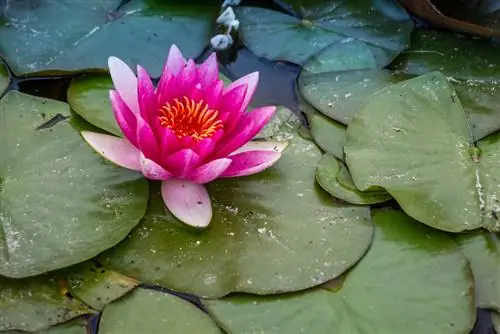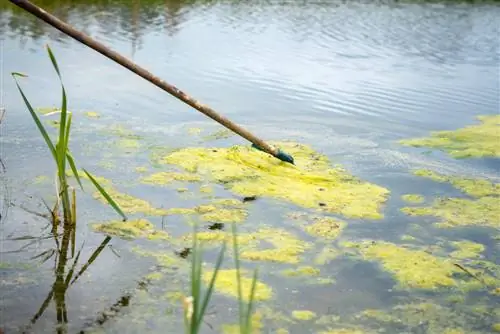- Author admin [email protected].
- Public 2023-12-16 16:46.
- Last modified 2025-01-23 11:22.
First of all, we can hardly wait for a freshly planted, still delicate water lily to grow lushly and show us its wonderful flowers. But their spread could soon reach proportions that we not only don't like, but that are extremely annoying. How to shrink them.

How to shrink water lilies in the pond?
To reduce the size of water lilies, you should cut them back at least annually between April and August, remove excess leaves and, if necessary, shorten or completely remove roots to limit the spread of the plants and make room for other aquatic plants.
Keep thinning out water lilies
Under favorable living conditions, water lilies spread so much that their leaves can cover the entire surface of a pond. There is hardly any room left for other aquatic plants. For their sake, too, you have to remove some of the water lilies.
An experienced pond owner doesn't let it get that far, because cutting the water lilies is part of his regular care.
- Prune water lilies at least annually
- during the period from April to August
- Take out the plant basket to cut back roots too
- cut specimens rooted in the pond bottom with pond shears
Fishing out leaves
If the water lily petals on the surface of the water are so numerous that they perhaps even overlap, you can fish out some of them. A rake (€47.00 on Amazon) with a long handle is helpful so that you don't have to climb into the pond. Use a landing net to remove leaves that are torn off and still floating in the water. This measure is a temporary solution because the plants will sprout again.
Also remove roots
If pruning has been neglected for a longer period of time, then the water lilies have certainly multiplied underwater. You can only make it smaller if you remove most of the roots. Since water lily roots can be very firmly attached to the substrate, this work is not always easy.
The easiest way to remove the rhizomes is in a small pond because you can climb into it and the roots are easily accessible at a manageable depth. However, if it is lined with foil, care must be taken to ensure that it is not damaged in the process. Whether you use a spade, a saw or just a sharp knife, you have to decide on site depending on the situation.
Tip
Remove any cut rhizomes from the water to prevent them from re-sprouting and contributing to renewed spread.






